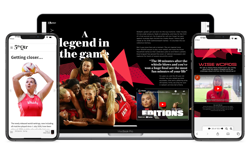
Where is customer media on the digital transformation journey?
Ann Hartland, group business and strategy director at customer media company Cedar Communications, works primarily on the British Airways account, producing the High Life in-flight magazine. During the pandemic, her team had to pivot to producing digital content in just eight weeks. She says: “From a BA perspective, we had to just get cracking on what does High Life look like as a digital platform? We weren’t naïve enough to not have started that journey. We reach out to our customers a lot. But we went from something that would have been months in the making to eight weeks.”
There had previously been a High Life website, but its role had not been clear. With customers no longer able to read the print magazine in-flight, Ann and her team had to work out what digital content would be of use to them. They have not given up on print though, and throughout lockdown continued to produce a print version of the magazine which was mailed out to the airline’s most valued customers. Hartland explains: “We wanted to be really clear what the role of High Life Digital was going to be. We quickly came up with the idea that High Life Digital is your trusted source of travel information.” She adds: “We already had research from consumers, so we knew what they would want if we went digital: more snackable content versus longer reads from High Life.” Hartland pays credit to Clare Broadbent, Cedar’s CEO, for letting the team get on with it. “I think she saw it the day before it went live and that was really empowering for the team. Eight weeks is not a long time.”
Key milestones
- Having previously launched a website that didn’t really take off, for the team covering BA at Cedar, Covid was the impetus needed to launch a digital product.
- Tesco, another Cedar client, already had an established website, but during the pandemic, the team responded by creating and curating appropriate content such as ‘Three Ways’: ideas for store cupboard meals that could be made with three simple ingredients for those who couldn’t get out to shop as much.
Lessons learnt
- Ann and her team soon realised that if they were to achieve their goal of pivoting to digital as quickly as possible, they had to give up on the idea of perfection. She says: “Launching with a minimum viable product, we could hit the go button on September 1st. We had to get rid of that idea of perfection, forget about it wanting to be all bells and whistles from day one.”
- They also concluded that making High Life Digital a work in progress which could be added to over time was the best way to progress. “We quickly made the decision for it to be issue based. We were never going to launch with hundreds and thousands of pieces of content. We were not going to be in that position, so we had to be really clear it was going to be a September issue and it would be updated.”
Where does customer media need to get to and how does it get there?
Hartland believes the customer will dictate how they want content to be delivered to them going forward. She says: “Digital is all about that end user. Everything else is irrelevant. It’s up to our users to dictate and determine that. Unless you take the Steve Jobs approach: people don’t know what they want until you give it to them.”
What does the future hold?
For BA, the shift to digital is not simply about moving with the times or responding to the pandemic, there are also pressing environmental considerations. Hartland explains: “We want to keep checking in with our customers. We’d done some user groups and focus groups in January 2020 to really interrogate our message and ask that digital question. The elephant in the room is the environmental impact and we felt that was really building. Airlines were under fire for what they were carrying that they didn’t need to, and magazines were the obvious one. They added weight so a digital solution seemed like an obvious one.”
That said, she firmly believes there is still a place for print: “We’re not taking our eye off print, we can see it coming back, people wanting that lie back approach, rather than push, push, push all the time.”
Customer media SWOT
STRENGTHS:
The ability to pivot quickly.
WEAKNESSES:
Trying to aim for perfection.
OPPORTUNITIES:
Focus grouping customers to find out how they want content delivered.
THREATS:
Uncertainty about the future.
This article is part of our special feature on The Digital Transformation Journey, originally published in April in conjunction with The Publishing Show. The feature contains the following six articles:
National news media, with Dominic Carter
Regional news media, with David Higgerson
Consumer media, with Jess Burney
B2B media, with John Barnes
Customer media, with Ann Hartland
Scientific / academic media, with Sara Sharman










